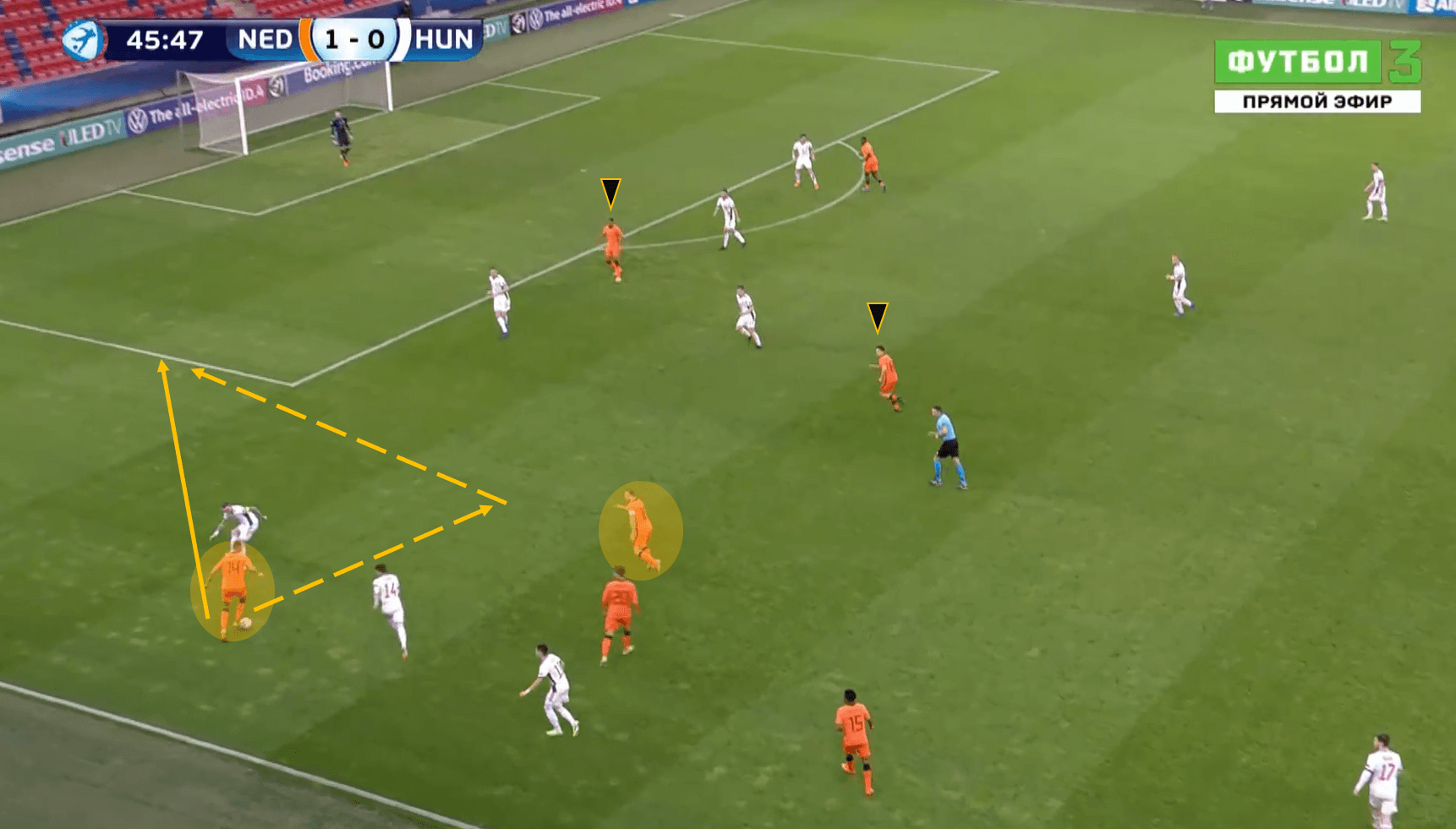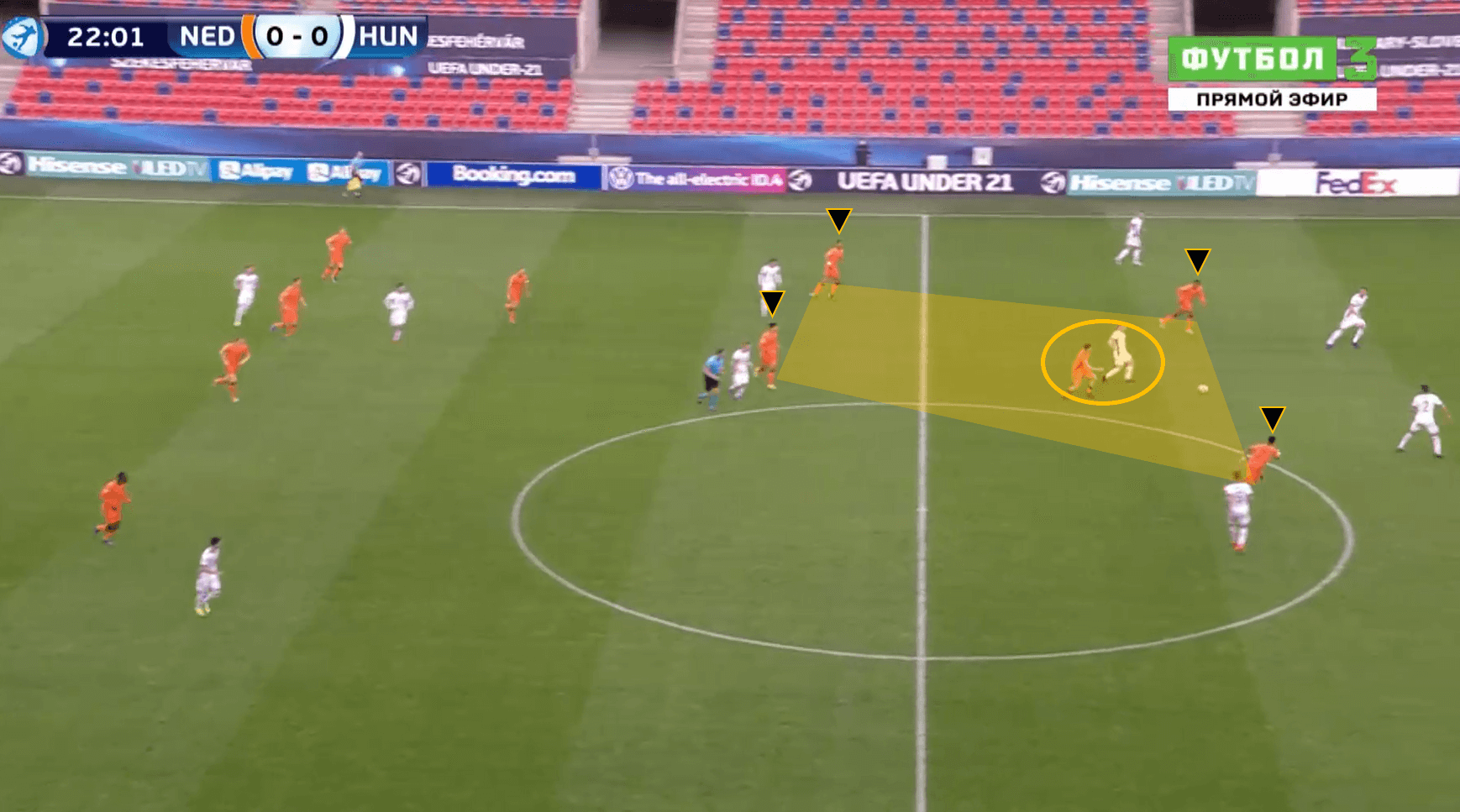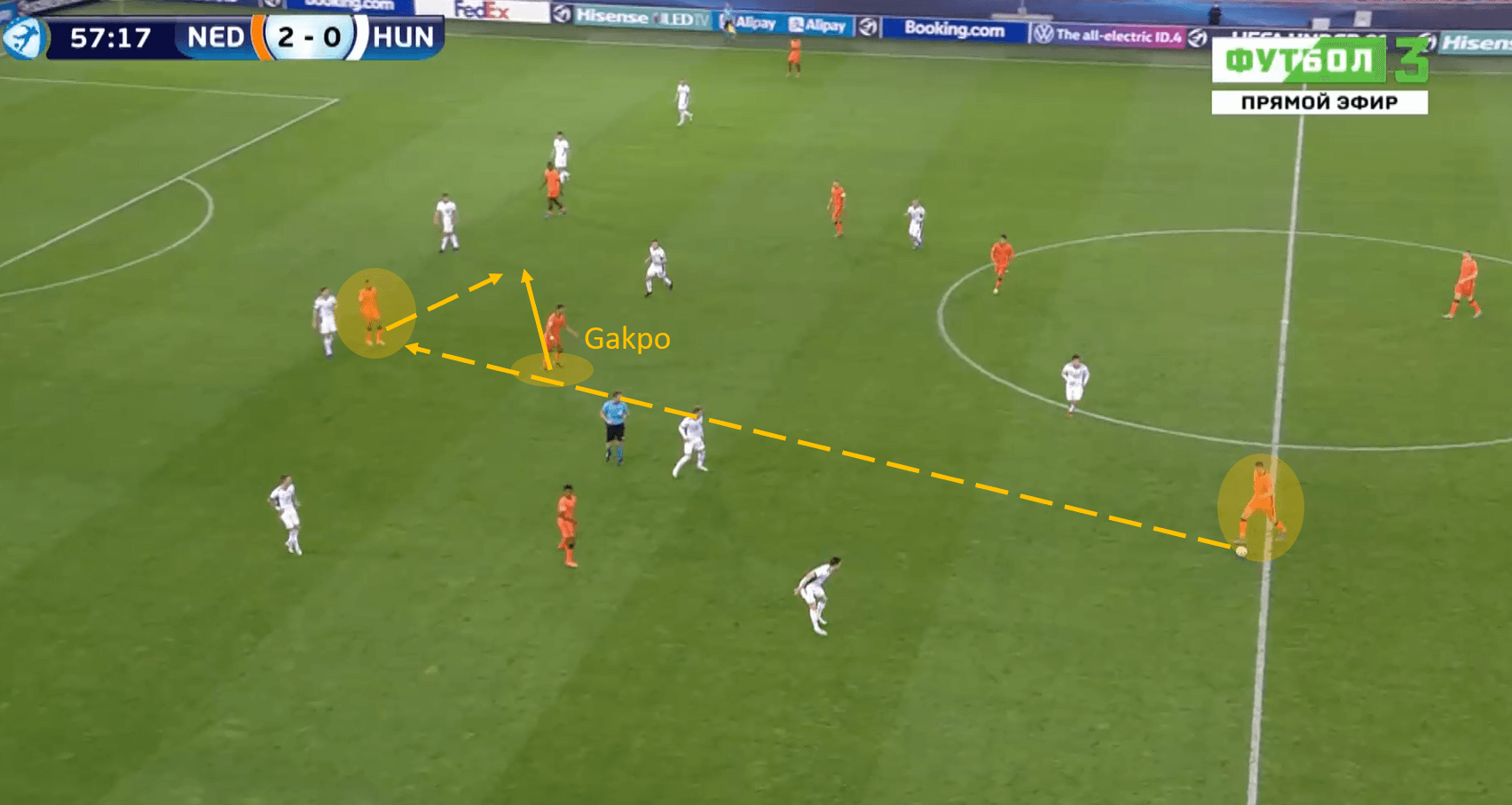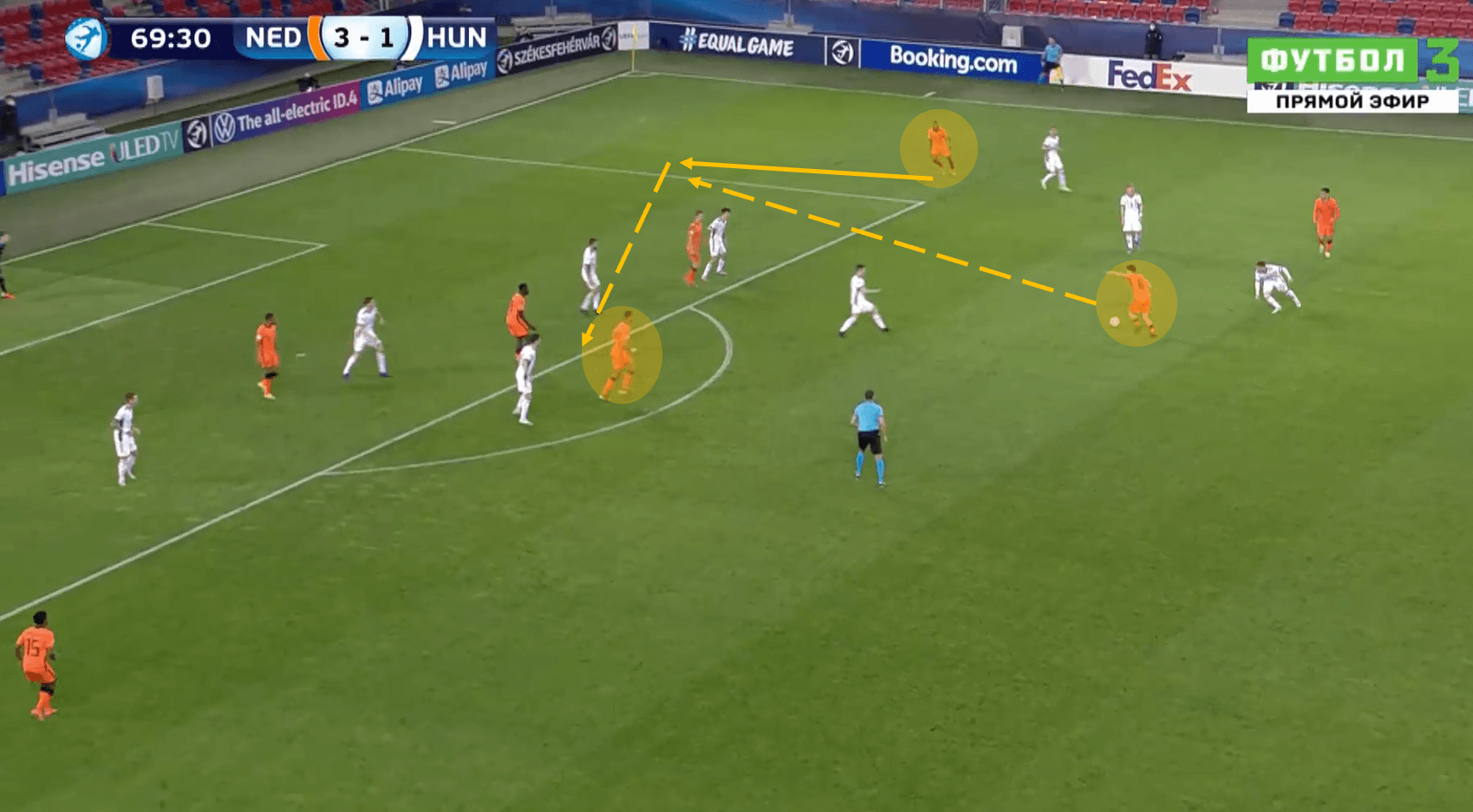After drawing their opening two games of the UEFA European U21 Championship against Romania and Germany respectively, Netherlands found themselves under some pressure to produce a convincing result against Hungary to secure their qualification for the knockout phase. The Dutch were scoring for fun in their qualifying group in 2019 and 2021, and they found their deadly attacking touch once more as they brushed past the Hungarians by a score-line of 6-1. This result allowed the Netherlands to finish top of their group on goal difference, earning themselves a quarter-final tie against France on May 31st. This tactical analysis will look to cover the key attacking aspects of this Dutch U21 side, as well as a look at how they operated out of possession too.
Netherlands Line-up

The Dutch deployed a 4-1-3-2 shape, which immediately outlines their intent to play an aggressive and attacking system. From left to right, the back four consisted of Mitchel Bakker who is currently on the books of Ligue 1’s PSG, the highly-rated Sven Botman of Lille, Perr Schuurs of Eredivisie leaders Ajax, and PSV’s Jordan Teze. The sitting midfielder role was undertaken by Sparta Rotterdam’s Abdou Harroui, with captain Dani de Wit (Alkmaar) in front of him. Wide support came from Cody Gakpo (PSV) and Ferdi Kadioglu (Fenerbahçe). Justin Kluivert and Myron Boadu were the attacking duo leading the line.
Utilising the flanks
While the Netherlands did explore a variety of attacking outlets in this fixture, they showed great creativity and fluidity in their wing play. Their shape allowed the two wingers to essentially play as wide playmakers, with a mixture of players providing support in the flanks and channels.

In the analysis above, we see the right-back Jordan Teze in possession, with the Dutch committing a strong number of players forward in good positions. The original player to start on the right flank was Kadioglu; his role allowed him to drift inside and create space for others. In this case, along with plenty others, it was Kluivert making the darting run into the channel, utilising his pace. Notice the angle he is making the run at – it drags his marker out wide, creating more space for the central runner, Dani de Wit. De Wit used the fluidity of the Dutch system to his advantage by taking up this position, and if the quality of the final ball through to him was better, a golden chance would’ve been created.

We also saw wing play that was slightly more traditional from the Netherlands, particularly as the game grew and they were able to control possession more comfortably. Their relentless attacking system helped pin the Hungarians deep in their own half, allowing the Dutch full-backs to join the attack, often creating an overload in wide areas. Above is an example of a 3-on-2 situation executed perfectly: Teze receives the ball, causing the Hungary left-back to instigate a press, except he wasn’t quick enough. This allowed Kadioglu an abundance of space in a high and wide position, which was recognised by Teze. Kadioglu received the ball and worked himself into a promising position, but as with the first analysis segment, the final ball was poor. In this game, we saw Teze take up positions like this one quite often. His skill set makes him a strong addition to a wide attack as he can use his pace, strength, and good dribbling ability to push the attack on.

Something we saw in a multitude of areas from the Dutch was the execution of combination plays – the chemistry in the team was very impressive. In this example, they were able to pull of a 1-2 combination out wide: de Wit was involved once more as he was able to find space inside of Gakpo, who used his pace to get past his counterpart to receive the return ball from de Wit, which was perfectly weighted. After a good first touch from Gakpo, he was fouled, resulting in a penalty. This is proof that the Dutch system encourages passing combinations – the old phrase “let the ball do the work” comes to mind: de Wit could have easily dribbled forward himself or passes elsewhere, but the fact that he instantly looked to return the ball to Gakpo shows what they are aiming for as a team.
Impressive off-the-ball work
Every good team needs to have a plan in place for when the opposition have possession – how they react in certain areas of the pitch is detrimental to winning the ball back quickly. While we didn’t see an extreme gegenpress for 90 minutes from this team, they displayed a desire to win the ball back quickly, particularly when pressing triggers occurred.

In this analysis above, we see the Netherlands applying a high press in the Hungary penalty area. The Hungarians looked to play their way out of trouble, and to their credit, they managed to escape this particular situation without taking any damage, but the Dutch press did its job and stopped their opponents from launching an attack. With Kadioǧlu and de Wit pressing the two Hungarians on the ball, the opportunity to play out from here became very limited. As the ball came out of the box into the central midfielder, Harroui instantly shut it down and stopped the Hungarian from turning and breaking forward – he was instead forced into making a pass which luckily ricocheted out for a Hungary throw. The focus here is on how the Dutch reacted to Hungary taking their time on the ball in such a deep area, and without any real urgency to break out. The reaction of the attacking players on hand to execute a press shows the good work done by the coaching staff.

Here we see the Netherlands reacting to a couple of pressing triggers, causing them to apply high pressure in midfield. However, again there is proof that this is something they have worked on during training, as it was well structured, and everyone played their role. Kluivert and Boadu closed down the two central defenders to limit their time on the ball, while Harroui and Gakpo both tucket inside to provide support for Kadioglu who was applying great pressure to the Hungarian. This press occurred after Hungary were able to get the ball forward to an isolated wide attacker, who was pressed quickly, and they were forced to play backwards before they could play forwards. The tactical and positional sense on show by the Dutch in this particular incident was very good, and it stopped their opponents from building any attacking momentum.
Easy on the eye in attack
Over the years, the Dutch have been responsible for some great and memorable attacking tactics and performances, and we saw flashes of great Dutch teams gone by in this fixture. The focus on combination play in a system of attacking fluidity was just a joy to watch, and more importantly, it was very effective. The analysis examples in this section all have one thing in common – the understanding of those Dutch players – between each other and the roles set to the tactically.

After winning the ball back following an attacking attempt from Hungary, the Dutch instantly looked to switch the play and launch an attack on the opposite flank where there was more space. They still kept the attack narrow, which allowed them to also exploit the gaps in central areas, allowing them to execute an impressive three-pass combination that led to Dani de Wit running clean through on goal to make it 1-0. The interesting part is that de Wit starts to make his move into that space between the central defenders before Bakker has even played the first pass of the sequence. It would be almost impossible to plan a passing sequence like this one to occur in exactly this situation, so it is only fair to assume that the Dutch were able to pull this off because of their great understanding of each other and of the tactics at hand. De Wit knew Gakpo would receive the ball from Boadu, which would leave him to run free on goal, and that is exactly what happened – another piece of fluid football from the Dutch. Despite it looking like the Hungarians had enough players present to defend such a situation, Netherlands showed a great ability throughout this game to exploit even the smallest spaces.

This analysis shows a slightly different, more direct approach being taken by the Netherlands. By no means is this a long-ball attack. But in comparison to their short passing combination and wing play, this is a little different. Again, it comes down to two key factors – chemistry and exploiting spaces. Botman is the man in possession above and has a number of passing opportunities in front of him. To his credit, he sees Gakpo in a good space in an advanced position and shows the vision and passing ability to pick him out. Despite two Hungarians being between Botman and Gakpo, their positioning (especially the midfielder) is poor, which allows for this pass to be executed. From here, it’s a moment of magic from Gakpo, who impressed in large amounts in this game. The pace on the pass from Botman allowed Gakpo to simply leave the ball – a dummy to let Boadu bounce the ball back into Gakpo who spun into the indicated space. This shows immense awareness and creativity from Gakpo, who knew that this would allow him to receive the ball in a much more dangerous location. He ended this attack by driving forward to the edge of the box before unleashing a deadly strike into the bottom corner.

In an earlier analysis segment, we touched upon Teze’s role in attack when Hungary were penned in. As the Dutch grew more confident and dominant, his attacking presence also grew. Good positioning and movement from Teze, combined with poor defensive awareness from Hungary allowed Teze to take up dangerous positions like the one above, with a clear gap for Kadioǧlu to slot the ball into. The heavy presence of Netherlands in the box indicates that they trust in their wing play as they had four players ready to get on the end of the cross. A good first touch and a brilliant cut-back-pass to Gakpo just inside the area allowed for a goal to end a very nice attacking move. The Dutch registered 26 shots in this game, and it is easy to see why when they can create chances through numerous attacking methods.
Conclusion
Of course, no team or player is the finished product at U21 level, but the amount of talent and potential in this Dutch squad is exciting. The majority of their starting 11 are already regular starters for top-tier clubs, and it isn’t a surprise when you see what they’re capable of. Their creativity and fearlessness in attack allows for some brilliant football that is simply hard to defend against. It looks like they found their form again at the right moment, and they will hope to pick back up from here when they face France in the quarter-finals.






Comments